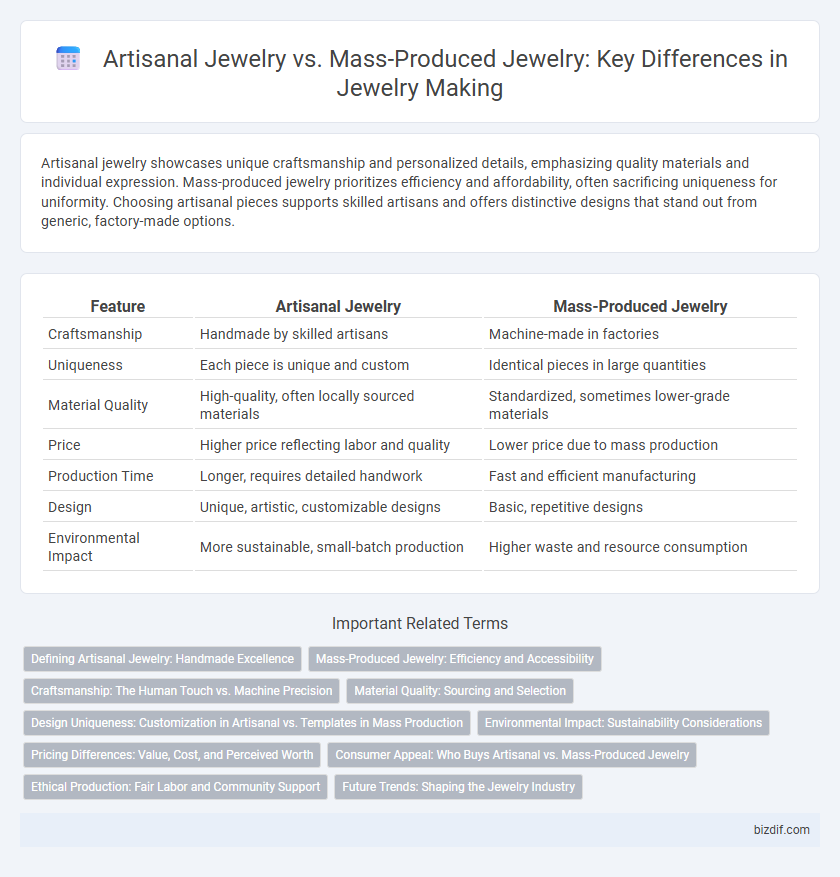Artisanal jewelry showcases unique craftsmanship and personalized details, emphasizing quality materials and individual expression. Mass-produced jewelry prioritizes efficiency and affordability, often sacrificing uniqueness for uniformity. Choosing artisanal pieces supports skilled artisans and offers distinctive designs that stand out from generic, factory-made options.
Table of Comparison
| Feature | Artisanal Jewelry | Mass-Produced Jewelry |
|---|---|---|
| Craftsmanship | Handmade by skilled artisans | Machine-made in factories |
| Uniqueness | Each piece is unique and custom | Identical pieces in large quantities |
| Material Quality | High-quality, often locally sourced materials | Standardized, sometimes lower-grade materials |
| Price | Higher price reflecting labor and quality | Lower price due to mass production |
| Production Time | Longer, requires detailed handwork | Fast and efficient manufacturing |
| Design | Unique, artistic, customizable designs | Basic, repetitive designs |
| Environmental Impact | More sustainable, small-batch production | Higher waste and resource consumption |
Defining Artisanal Jewelry: Handmade Excellence
Artisanal jewelry embodies handmade excellence through meticulous craftsmanship and unique design, often crafted by skilled artisans using traditional techniques. Each piece reflects individuality, superior quality, and attention to detail, distinguishing it from mass-produced jewelry assembled through automated processes. The use of high-quality materials and personalized artistry creates exclusive jewelry with intrinsic value and cultural significance.
Mass-Produced Jewelry: Efficiency and Accessibility
Mass-produced jewelry leverages automated manufacturing processes to ensure high efficiency and consistent quality across large volumes, significantly reducing production costs. This approach enables widespread accessibility by offering affordable and trendy designs to a broader consumer base. Despite limitations in customization, mass production meets market demands through rapid turnaround and scalable distribution networks.
Craftsmanship: The Human Touch vs. Machine Precision
Artisanal jewelry showcases exceptional craftsmanship through meticulous handwork, reflecting unique design elements and intricate details that machines cannot replicate. Each piece benefits from the artisan's personal skill and creativity, resulting in one-of-a-kind jewelry with subtle imperfections that add character and authenticity. In contrast, mass-produced jewelry relies on machine precision and automated processes to create uniform products quickly and cost-effectively, sacrificing individuality and the nuanced artistry found in handcrafted pieces.
Material Quality: Sourcing and Selection
Artisanal jewelry is crafted using carefully sourced, high-quality materials such as ethically mined gemstones and hand-selected precious metals, ensuring unique and durable pieces. In contrast, mass-produced jewelry often utilizes lower-grade materials or synthetic alternatives to reduce costs, leading to less durability and value. This difference in material quality significantly impacts the longevity, appearance, and overall authenticity of each jewelry type.
Design Uniqueness: Customization in Artisanal vs. Templates in Mass Production
Artisanal jewelry offers unparalleled design uniqueness through handcrafted customization tailored to individual preferences, resulting in one-of-a-kind pieces. In contrast, mass-produced jewelry relies on standardized templates and molds to create uniform items in large quantities, limiting personalization opportunities. This fundamental difference in design approach highlights the exclusive artistry inherent in artisanal jewelry versus the repetitive patterns characteristic of mass production.
Environmental Impact: Sustainability Considerations
Artisanal jewelry often incorporates recycled metals and ethically sourced gemstones, significantly reducing environmental degradation compared to mass-produced pieces, which typically rely on high-volume mining and chemical-intensive processes. Handcrafted methods prioritize minimal waste through precise material use and local sourcing, lowering carbon footprints and supporting sustainable practices. Mass production, by contrast, generates substantial industrial waste and energy consumption, contributing to pollution and habitat destruction at a larger scale.
Pricing Differences: Value, Cost, and Perceived Worth
Artisanal jewelry commands higher prices due to handcrafted techniques, unique designs, and superior material quality, reflecting greater perceived worth and intrinsic value. Mass-produced jewelry benefits from economies of scale, resulting in lower production costs and more affordable retail prices but often lacks the exclusivity and craftsmanship found in artisanal pieces. Consumers associate artisanal jewelry with authenticity and durability, which justifies the premium cost compared to more uniform, mass-produced alternatives.
Consumer Appeal: Who Buys Artisanal vs. Mass-Produced Jewelry
Artisanal jewelry appeals primarily to consumers seeking unique, handcrafted pieces that reflect individuality and craftsmanship, often valuing quality over quantity. Mass-produced jewelry attracts buyers who prioritize affordability, consistency, and trendy designs available in large volumes. This distinction influences purchasing decisions based on personal values, budget, and desire for exclusivity.
Ethical Production: Fair Labor and Community Support
Artisanal jewelry is crafted through fair labor practices that ensure skilled artisans receive equitable wages, promoting sustainable livelihoods and preserving cultural heritage. Unlike mass-produced jewelry, which often relies on low-cost labor and automated processes, artisanal pieces foster community support by empowering local economies and reducing exploitation. Ethical production in artisanal jewelry incorporates transparency in sourcing and manufacturing, aligning with growing consumer demand for socially responsible products.
Future Trends: Shaping the Jewelry Industry
Artisanal jewelry, characterized by handcrafted techniques and unique designs, is increasingly valued for its sustainability and personalization, contrasting with the uniformity of mass-produced jewelry. Future trends in jewelry making emphasize eco-friendly materials, digital customization, and integration of wearable technology, driving demand for bespoke pieces that blend tradition with innovation. These shifts are redefining consumer preferences and industry standards, promoting craftsmanship and ethical practices as key market differentiators.
Artisanal jewelry vs Mass-produced jewelry Infographic

 bizdif.com
bizdif.com